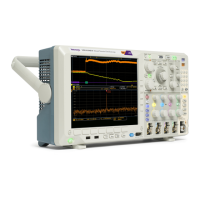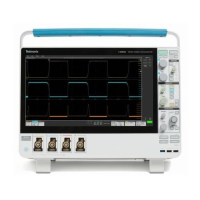Specifications
Table 4: Trigger specifications (cont.)
Characteristic Description
Pulse class Minimum pulse
width
Minimum rearm time
Glitch
4ns
2 ns + 5% of glitch width setting
Runt 4 ns 2 ns
Time-qualified runt
4ns
8.5 ns + 5% of width setting
Width 4 ns
2 ns + 5% of width upper limit setting
Slew rate
4ns
8.5 ns + 5% of delta time setting
Pulse type trigger, minimum pulse,
rearm time, minimum transition time
For the trigger class width and the trigger class runt, the pulse width refers to the width of the
pulse being measured. The rearm time refers to the time between pulses.
For the trigger class slew rate, the pulse width refers to the delta time being measured. The
rearm time refers to the time it takes the signal to cross the two trigger thresholds again.
Transition time trigger, delta time
range
4nsto8s
Time range for glitch, pulse width,
timeout, time-qualified runt, or
time-qualified window triggering
4nsto8s
B trigger after events, minimum
pulse width and maximum event
frequency, typical
4 ns, 500 MHz
B trigger, minimum time between
arm and trigger, typical
4ns
For trigger after time, this is the time between the end of the time period and the B trigger
event.
For trigger after events, this is the tim e between the last A trigger event and the first B trigger
event.
B trigger after time, time range
4nsto8seconds
B trigger after events, event range
1 to 9,999,999
Maximum serial trigger bits 128 bits
Standard Parallel bus interface
triggering (MSO4000 only)
Data Trigger: 1 to 20 bits of user specified data on 4-channel models and 1 to 18 bits of
user specified data on 2-channel models.
10 MSO4000 and DPO4000 Series Specifications and Performance Verification

